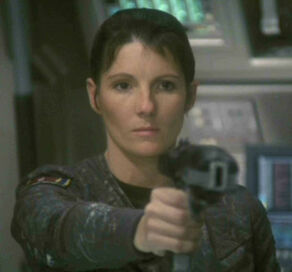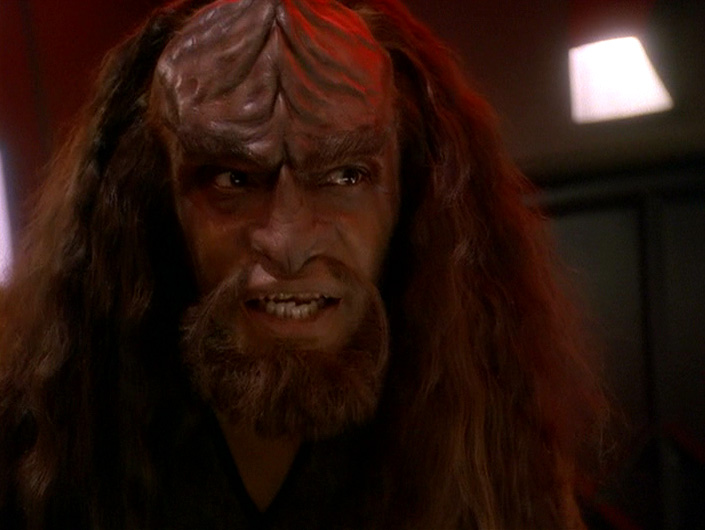--------------------
Welcome back to Character Insight! This week, we continue our "Best Of" series with a look at some of the best episodes for advancing the character of the holographic doctor on Voyager, also known as the EMH.

(The first version of the EMH, courtesy memory-alpha.org)
Star Trek often does character development best with the different characters like Spock and Data, and The Doctor in Voyager is just another final frontier of character development, specifically holographic intelligence. From the moment the EMH is granted access over his own activation and program by Janeway in season 1, he develops more and more into a regular member of the stranded crew.
In the episode Projections, the Doctor hallucinates about the nature of his real or holographic existence, and his programming defenses do not step in to stop this:
The Doctor: I experienced an elaborate delusion concerning the nature of my existence: human or hologram, person... or projection. Why? Why would my program focus on such an esoteric dilemma?
Kes: Well... I sometimes ask those kind of questions. Who am I? What am I doing here? What's my purpose in life? Doesn't everybody?
The Doctor: Not me. I know exactly who I am and what my purpose is: I am the Emergency Medical Hologram aboard the starship Voyager.
In the episode Lifesigns, the Doctor falls in love with a holographic representation of a Vidiian scientist named Denara who he was treating for the phage, and he must deal with these new feelings and emotions:
Dr. Danara Pel: Before I met you, I was just a disease. But now, everything's different. When people look at me, they don't see a disease anymore. They see a woman - a woman you made, a woman you love, a woman you're not afraid to touch.
The Doctor: Danara, I was never afraid to touch you.
Dr. Danara Pel: Why? Because you're a doctor?
The Doctor: Because I love you.
In the episode Real Life, the Doctor learns how to be a father in a human family while on his free time in the holodeck, including how to deal with severe grief when his daughter dies in an accident:
Lieutenant Tom Paris: I guess all of us would avoid that kind of pain if we could. But most people don't have that choice. The Doctor: Well, fortunately I do. Lieutenant Tom Paris: Is it so fortunate? You created that program so you could experience what it's like to have a family. The good times and the bad. You can't have one without the other. The Doctor: I fail to see why not. Lieutenant Tom Paris: Think about what's happened to us here on Voyager. Everyone left people behind, and everyone suffered a loss. But... look how it's brought us all closer together. We found support here, and friendship, and we've become a family, in part because of the pain we shared. If you turn your back on this program, you'll always be stuck at this point. You'll never have the chance to say goodbye to your daughter. Or to be there for your wife and son when they need you. And you'll be cheating yourself of the chance to have their love and support. In the long run, you'll miss the whole point of what it means to have a family.
In the episode Revulsion, the Doctor and B'Elanna Torres try to help a stranded hologram on a ship, but they end up needing to defeat him when he turns on them after they reveal he killed his organic crew after being driven mad by being treated like a tool rather than as an intelligent being, which is an interesting contrast for the Doctor on Voyager:
The Doctor: Not so fast, Mr. Paris. You are going to help me sterilize every square millimeter of this sickbay. No doubt you've left your oily residue on every hypospray, your sloughed secretions on every console! - Just kidding. In fact, I've had a change of heart about my fastidiousness. A little clutter'll never hurt anyone. Sickbay should have a more organic touch, don't you think? To help our patients feel... more at home? Tom Paris: [to Torres] What's gotten into him? B'Elanna Torres: It's a long story.
Finally, in the episode Latent Image, the Doctor discovers that his memories about a dead ensign were deleted because he had made a decision to treat Harry Kim when he couldn't treat both crew members critically injured on an away mission, which led to a personal breakdown and inability to function. The crew helps him on the second time deal with his feelings and guilt to help him understand everyone overcomes tough decisions:
The Doctor: Causality - probability. For every action, there's an infinite number of reactions, and in each one of them, I killed her. Or did I? Too many possibilities; too many pathways for my program to follow. Impossible to choose. Still, I... I can't live with the knowledge of what I've done, I can't.
Other good episodes to check out for The Doctor include Equinox, Tinker Tenor Doctor Spy, Lifeline, Flesh and Blood, and Renaissance Man. You could honestly do two "Best Of" segments with this character, as his development into a brilliant, compassionate, and loyal crewmate and man is one of the most beautiful character arcs provided in Star Trek history.
The Doctor was played by Robert Picardo, who is a very interesting person to follow on Twitter these days.
------------
Feedback can be sent to me with future segment suggestions on Twitter @BuckeyeFitzy. Until next time, live long and prosper...



